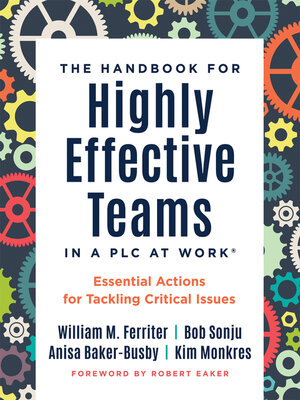Handbook for Highly Effective Teams in a PLC at Work®
ebook ∣ Essential Actions for Tackling Critical Issues (Building highly effective teams)
By William M. Ferriter

Sign up to save your library
With an OverDrive account, you can save your favorite libraries for at-a-glance information about availability. Find out more about OverDrive accounts.
Find this title in Libby, the library reading app by OverDrive.



Search for a digital library with this title
Title found at these libraries:
| Library Name | Distance |
|---|---|
| Loading... |
Transform your teacher teams into the driving force of student success and collaboration with this practical, action-driven guide. A companion to Learning by Doing, this handbook delivers 15 essential actions that highly effective teams use to strengthen collaboration, clarify student learning goals, use assessments as powerful learning tools, and ensure every student gets the time and support they need to learn at high levels. This easy-to-read, conversational book provides the tools, strategies, and real-world insights teams need to boost student achievement.
Perfect for K–12 administrators, teachers, and instructional coaches, this book will help you:
Contents:
Introduction: The Promise of Highly Effective Teams
Part 1: Highly Effective Teams Have a Common Foundation
Chapter 1: Essential Action—Identify Team Roles, Norms, and Protocols
Chapter 2: Essential Action—Outline a Process for Addressing Personality Interference With Teamwork
Chapter 3: Essential Action—Analyze Achievement Data and Establish SMART Goals
Chapter 4: Essential Action—Formally Evaluate the Team's Effectiveness at Least Twice Yearly
Part 2: Highly Effective Teams Focus on Learning for All Students
Chapter 5: Essential Action—Ensure Clarity on the Knowledge, Skills, and Dispositions Students Will Acquire
Chapter 6: Essential Action—Collectively Study Essential Learning and Clearly Define Mastery
Chapter 7: Essential Action—Establish Clear Criteria for Student Work and Continually Apply Those for Consistency
Chapter 8: Essential Action—Identify Prerequisite Knowledge and Skills Needed to Master Essential Learning
Chapter 9: Essential Action—Teach Students the Criteria We Use in Judging Their Work
Chapter 10: Essential Action—Make Visible a Set of Exemplars for Students
Chapter 11: Essential Action—Use Short-Term Goal Setting
Chapter 12: Essential Action—Identify Course Content and Topics We Can Eliminate to Devote More Time to Essential Curriculum
Chapter 13: Essential Action—Agree How to Sequence Content and Pace the Course
Chapter 14: Essential Action—Use Materials and Professional Expertise to Identify Instructional Strategies
Part 3: Highly Effective Teams Effectively Use Assessments and Data
Chapter 15: Essential Action—Use Team-Created Pretests to Assess Prerequisite Knowledge and Skills
Chapter 16: Essential Action—Develop Common Formative Assessments for Frequent Administration
Chapter 17: Essential Action—Administer Common Formative Assessments Throughout a Unit
Chapter 18: Essential Action—Use Standardized Testing Data and District Benchmarks to Assess Strengths and Weaknesses
Chapter 19: Essential Action—Use Team Assessment Results to Identify Students in Need of Additional Time and Support
Chapter 20: Essential Action—Use Assessment Results to Identify Strategies That Help More Students Master Essentials
Part 4: Highly Effective Teams Provide Extra Time and Support for Learning
Chapter 21: Essential Action—Develop Strategies and Systems to Help...







